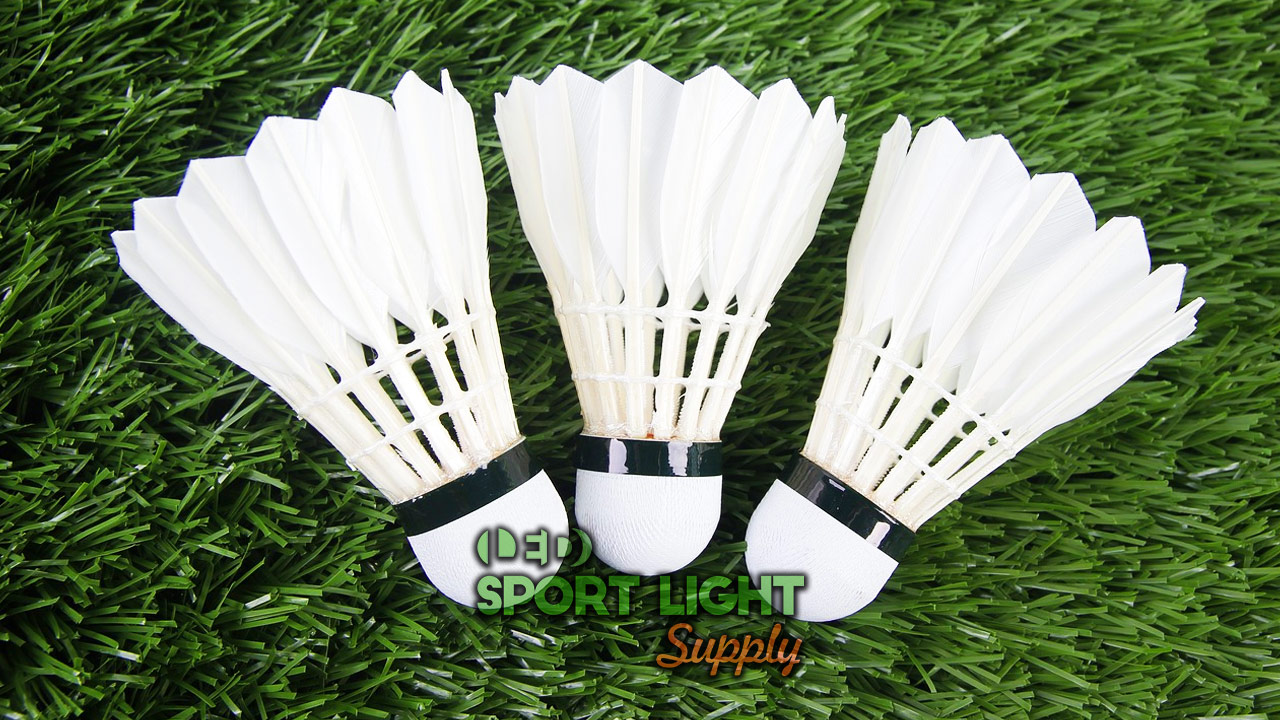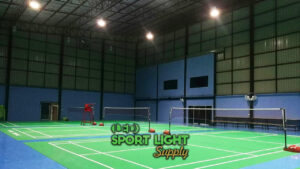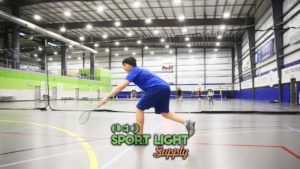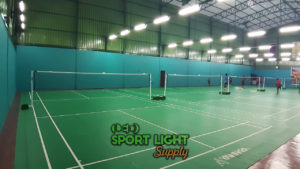One of the underappreciated parts of any badminton court is always the lighting. To get your badminton court professionally lit takes some planning. In the end, you have better visibility and light uniformity. This can lead to more players who want to plan their badminton games on a court that’s lit better using modern LED lighting. Here’s what you need to know when planning the lighting design of your badminton court.
What is an outdoor badminton court lighting design?
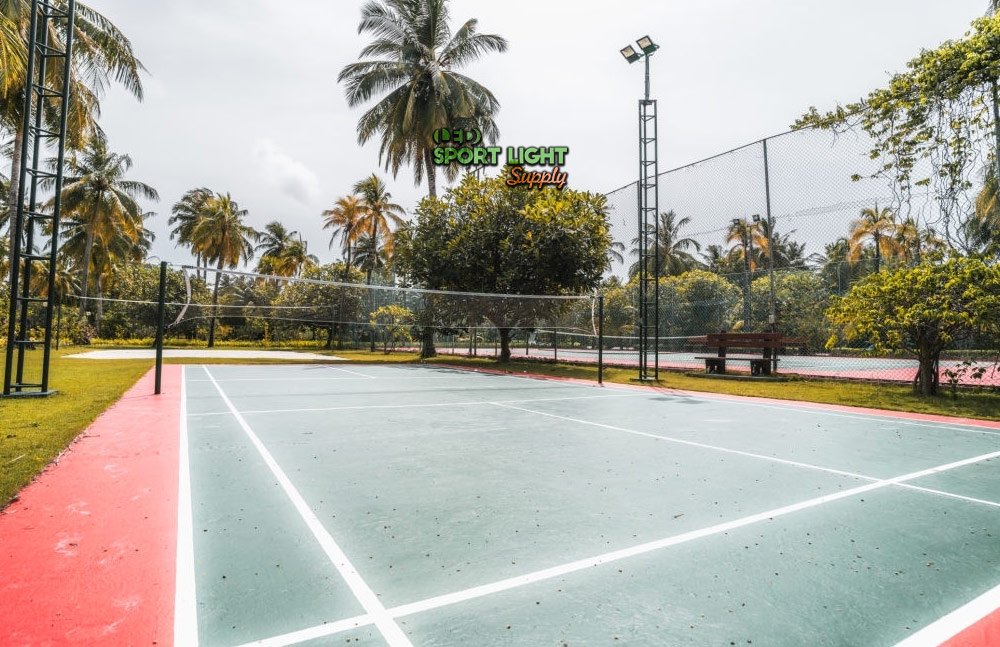
The definition of outdoor badminton court lighting is giving any outdoor court lighting designs for better illumination at any hour. This increases the availability of badminton courts for those who want to practice at dusk or at night when light is scarce. Because of the court size and layout, the lighting design depends on important factors. These include the lighting layout and pole arrangement.
It also considers pole height and the number of poles used. Then after this, the Lumens and Lux are calculated along with beam angles. Then after all is preplanned, the color temperature for correct Kelvin is determined.
How to get started with lighting design for an outdoor badminton court?
1. Number of light poles (4,6, or 8 poles)
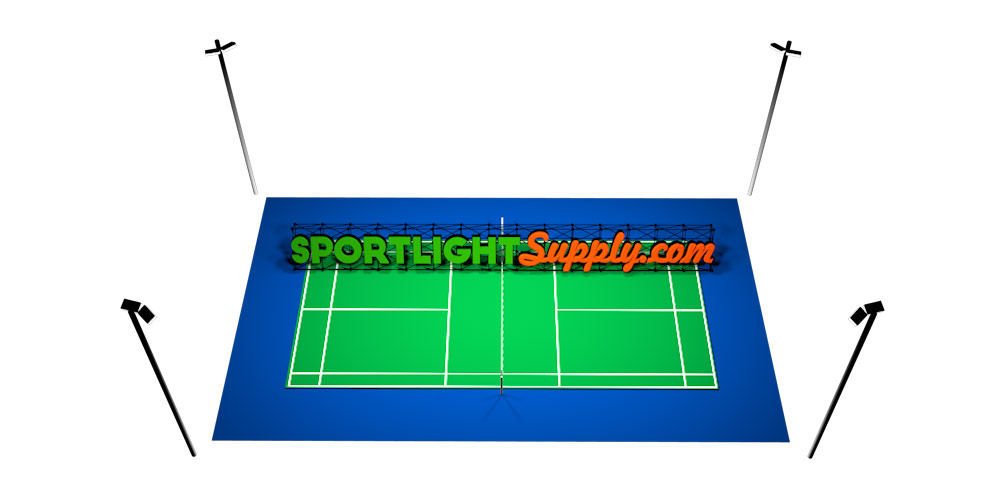
With any outdoor court, you need to consider the potential for how many lights are needed. The standard layout will often include 4 poles which are obviously a tip-off. The higher the number of poles also determines the level of professionalism that is played on that court. It could be for competitions or even championship games. So, of course, the number of lights needs to be increased.
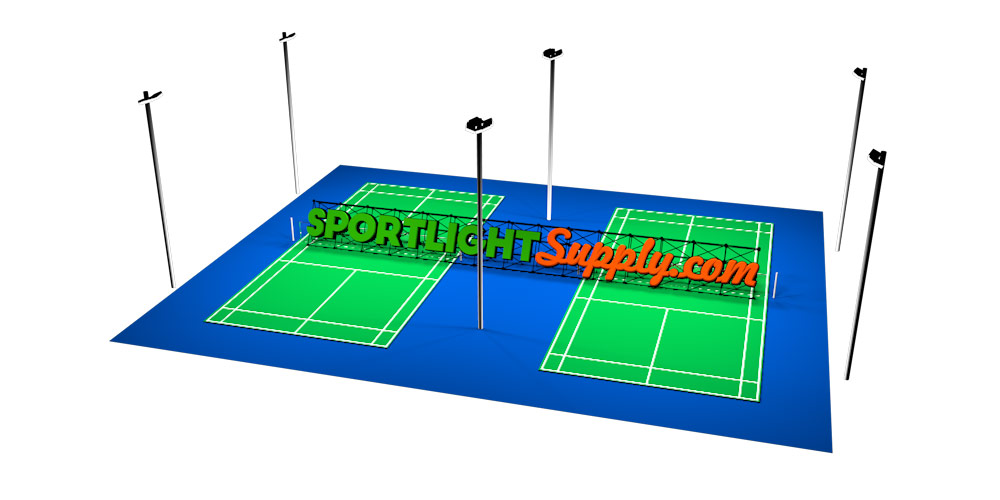
But this all depends on the type of space that you have available for lighting an outdoor court. Badminton courts do take up a specific amount of space and you may have adjoining courts lined-up. This would allow a lighting layout to include more than 6 light poles that are positioned strategically.
2. Pole position
One thing that needs to be expressed is where poles are bet placed at the outdoor court. It seems that the space that runs along the sidelines is the best area to place light poles. At the very corner of each badminton court, this is where corner lights need to go. The essential need to have light uniformity is taken into consideration too. If you are attracting professional players, a court that’s lit with higher CRI and Lux will be more attractive.
The distance from the sidelines will have required measurements of how far from the court they are placed. But recreational courts will often follow a similar approach, just not as a strict requirement.
3. Badminton court light pole height
When any outdoor lighting is used for illuminating the badminton court, you need to have tall light poles. The height is best if poles are at least 30 feet tall. They must not be in the way of the birdie, so these poles must be placed outside the edges of the badminton court. This height is the best height for achieving uniform light coverage at each corner. If there are additional poles added this allows the reduction of corner shadows
The height of these light poles must be clear of any obstructions such as trees or foliage. This is so the badminton court will have optimal light spread across the surface.
4. Lumen and Lux of outdoor badminton court lights
a) Recreational
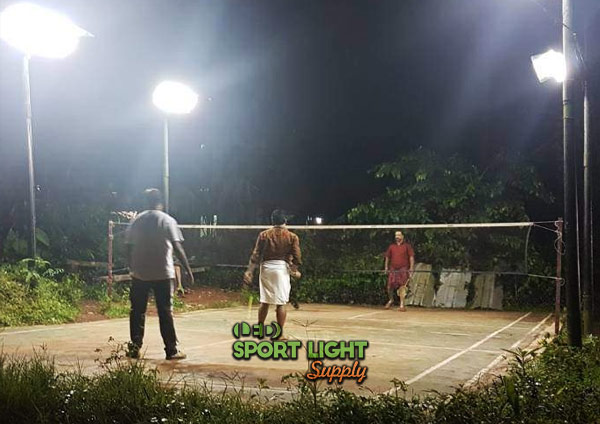 Many outdoor badminton courts are just for outdoor fun and games and don’t need to be so over-the-top. The lighting that is measured for Lumens also is measured for Lux rating. This is when the amount of Lux is measured it’s based on a specific grid that’s measured. This is the total amount of light that’s across the badminton field. You’ll need 200-300 Lux for a recreational badminton field.
Many outdoor badminton courts are just for outdoor fun and games and don’t need to be so over-the-top. The lighting that is measured for Lumens also is measured for Lux rating. This is when the amount of Lux is measured it’s based on a specific grid that’s measured. This is the total amount of light that’s across the badminton field. You’ll need 200-300 Lux for a recreational badminton field.
It doesn’t need to be so overly lit up, but this is still an excellent amount of light. For nighttime lighting, this will give more than enough visible field light.
b) Training
For training purposes, you need to step-up the lighting level a bit more. Trainers who are getting ready for big competitions will want to have amble lighting. This is why training courts need at least 300-500 Lux so the athletes have more available light. This lighting is still laid back compared to larger competitions. This is what makes training lighting a bit more relaxed light-wise.
Training lights should be well-lit, but the amount of light through Lux isn’t going to be overbearing. They can practice without having lights that are too bright or exciting. This also makes it more beneficial so they don’t risk injuries for practice and training.
c) Community competition
At the level of bigger competitions or at private clubs, you can bet that the lighting needs to be brighter. The amount used for community competitions is going to have 500-700 Lux on these badminton courts. The reason for this is because there can be some kind of television and camera coverage. So therefore the lighting will be brighter levels of Lux so the images will stand out more.
This can also be for an audience that is watching if there are bleachers or a viewing area. This amount of light is standard for professional and semi-professional badminton players. It’s not limited to regional players who are having local badminton matches either.
d) National or international tournaments
When it comes down to BWF world championships and Olympic Games, you need professional lighting. This is the highest amount of light that will be used to illuminate the court and the players. You will normally see 1000-2000 Lux lighting up the court. This might sound like a lot of light and in one sense it is. But for the cameras that are doing slow-motion replays, this is essential.
National and international tournaments need light to make the court super well-lit just like a surgeon’s table. There is no mistake for this level of lighting that needs every square inch lit up with precision.
5. Lighting uniformity
Lighting up a badminton court is no different than a tennis court. The lighting uniformity is just as important when professional competition sports are played-out. This kind of lighting is not only measured for luminous levels for professional matches but even for moderate lighting jobs. This can also apply to recreational courts where private clubs need pro lighting. Light uniformity can be measured using horizontal and vertical calculations on a pro court.
It allows a court owner to let professional players know their court is specified to meet standard light levels. This is when competitions and championship matches are played. It’s also a good plan for allowing TV cameras to capture the right amount of light needed additionally.
6. Spill light
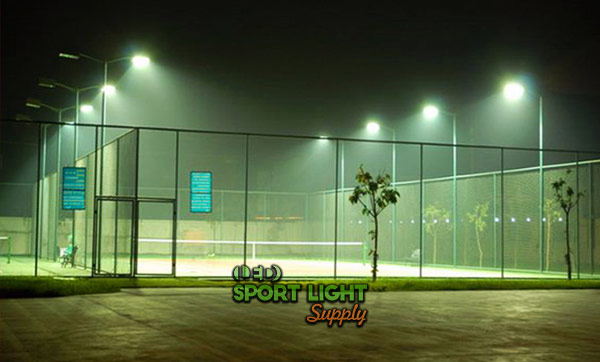 As it might turn out, there is always going to be spill light (light pollution) when outdoor LED lighting is used. Any floodlight will have a percentage of spill-light that goes over the badminton court. This can be controlled using select angles to keep this light from migrating off the court itself. It shouldn’t be irritating to spectators if the light is kept under control. Especially for pro courts that will have many lights installed for uniformity.
As it might turn out, there is always going to be spill light (light pollution) when outdoor LED lighting is used. Any floodlight will have a percentage of spill-light that goes over the badminton court. This can be controlled using select angles to keep this light from migrating off the court itself. It shouldn’t be irritating to spectators if the light is kept under control. Especially for pro courts that will have many lights installed for uniformity.
There might be issues with a bit of glare, but keep in mind that LED lights are highly directional. This keeps glare to a minimum and lets spectators and players see the light without it being uncomfortable.
7. Beam angle
The beam angle used for badminton lights will come down to the angle they are aimed at. The height of the pole and the angle the lights are pointed on the court determines which angle to use. For professional courts, these angles are predetermined using computer software. When using floodlights for close range and spotlights for long-range, these two angles may differ slightly.
Animation models can ensure that the angle arrangement used will troubleshoot how well a court is the best lit. This makes installation much easier and less guesswork is done calculating the angle for each light used. It also helps give the court more light coverage using an essential requirement of calculations.
8. Angle of projection
You’ll want to know where to point the lights in a badminton court, but there is another issue you don’t know. There is always the need to have a certain amount of lumens projected due to the distances. Even though these are very short lengths from overhead lights on poles, there can be some light loss. These calculations are also measured beforehand and keep a light level constant.
Angle projection estimates that 1 or 2% of the light will be lost and the adjusted Lumens are added. You won’t lose any kind of light level because it takes this light loss into account. No matter the distance involved, because this adjustment covers for the possibility, the court will always have the perfect Lumen count.
9. Color temperature
Different light levels for badminton courts will all have light levels that are appropriate for their usage. Most people don’t know that color temperature is an important feature of LED light that can be adjusted. For badminton, you can expect that 5000-6000K with white light will be preferred. Practice courts can be lower in the 4500K levels but never below this. Anything that has warmer colors that include red or pink should be avoided.
With badminton, the focus is being able to spot the birdie and this works best with white light. Professional matches can be high as 5000-6000K but not higher. Practice courts would be fine with 4000-4500K lighting.
10. Waterproof rating of outdoor badminton lighting
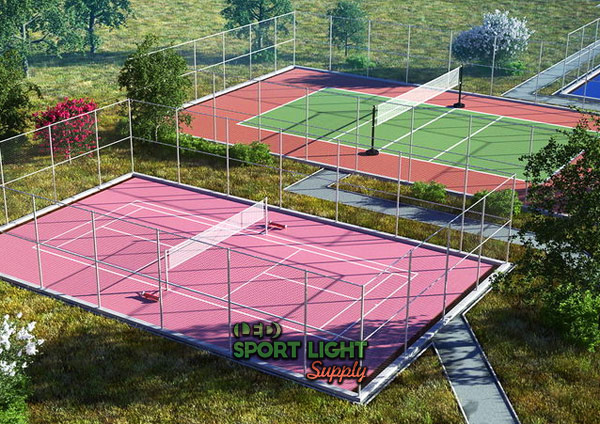 Outdoor weather is always unpredictable if you live in a climate that has wet or rainy weather. This is why playing badminton is better if you can play inside. But installing any kind of LED lights outside needs an IP rating that protects them. You will want an IP rating that is suited to the conditions that your area is experiencing. Any kind of wet weather needs at least IP 65, 66, or 67 attached to it.
Outdoor weather is always unpredictable if you live in a climate that has wet or rainy weather. This is why playing badminton is better if you can play inside. But installing any kind of LED lights outside needs an IP rating that protects them. You will want an IP rating that is suited to the conditions that your area is experiencing. Any kind of wet weather needs at least IP 65, 66, or 67 attached to it.
The higher the number, the better suited that LED fixture will be to resist water. Even if there’s moderately dry weather all year long, a light drizzle can damage lights. It’s just a good idea to have that protection so your LED lights last longer.
Importance of getting a good lighting layout for outdoor badminton court
1. Better vision for badminton players
You will want to have enough brightness and light uniformity across the entire badminton court. Athletes need to see what they are doing and where the birdie is flying. If a court is well lit from all angles and also from sidelights, they’ll have better vision. Birdies can travel up to 200 miles-per-hour at some points. This is why lights need to be bright to see that fast movement.
If a team has larger matches, players need to see where their position is at all times. Adequate lighting shows details that are needed so nothing is left in the shadows. This way a team can work together to an advantage using this level of light.
2. For broadcasting events
On all events that are shown on TV, the amount of light needed for the special cameras needs good lighting. This gives the best image possible without the lighting being too overbearing. Slow-motion cameras can capture images that are crystal clear. When played back for instant replays, a viewer can see little details that are clear and defined. Often these can be used for training purposes to see how movements can be adjusted.
3. Attract more players
Having good lighting is essential for badminton clubs of all sorts. Potential players who are serious about their game would like to book a bright badminton court. It can attract those who are semi-pro or professionals who want to practice privately. It can also be appealing to those who don’t have time to in the day. With nice bright lighting, the conditions of daytime play are then possible for arrangement sessions anytime outside at night.
4. For security and management
At night when a private club is closed, it can be ideal for bright lighting for security reasons. This would allow CCTV to capture clear footage of anything that gets on the court. Especially if there are sneaky or suspicious people around or near the badminton courts. Having a private club doesn’t exclude some people from trying to play at night and for free. It’s an added extra that can be an attractive requirement for management and security reasons.
Conclusion
With all of the helpful info that you can find here, I hope that you’ve learned more about badminton lighting. When the need arises that your court needs an upgrade or professional LED lights, it can help players too. To maintain the best athlete levels, the lighting for any size court can be achieved. Don’t hesitate to ask us further what is needed to plan when lighting up your court soon.

